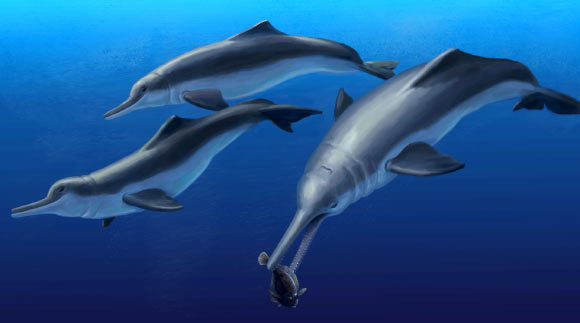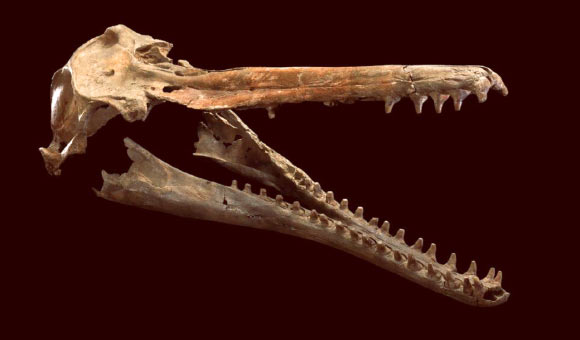The fossil of a freshwater river dolphin that lived 5.8 – 6.1 million years ago has been found in Panama.

Life reconstruction of Isthminia panamensis, feeding on a flatfish, which would have been abundant in the neritic zone of the late Miocene equatorial seas of Panama. Image credit: Julia Molnar.
The fossil, which is that of a new genus and species, was found on the Caribbean coast near the town of Piña.
It consists of half a skull, lower jaw with an almost entire set of conical teeth, right shoulder blade and two small bones from the flipper. In comparison with other river dolphins, the shape and size of these parts suggest that the specimen may have been more than 9 feet (2.7 m) in length.
Dr Nicholas Pyenson from the Smithsonian’s National Museum of Natural History and co-authors named the new dolphin Isthminia panamensis.
“Isthm– reflects the type specimen’s provenance from the Isthmus of Panama and the crucial role that the formation of this isthmus played in Earth history and evolution of the biota of the Americas,” Dr Pyenson and his colleagues wrote in a paper published in the journal PeerJ. “The feminine generic epithet –inia reflects its similarities to the living Amazon River dolphin.”
“The species epithet, panamensis, recognizes the Republic of Panama, its people, and the many generations of scientists who have studied its geological and biological histories.”
“We discovered this new fossil in marine rocks, and many of the features of its skull and jaws point to it having been a marine inhabitant, like modern oceanic dolphins,” Dr Pyenson said.
Today there are only five species of river dolphins – the South Asian river dolphin (Platanista gangetica), Amazon river dolphin (Inia geoffrensis), Araguaian river dolphin (Inia araguaiaensis), Bolivian river dolphin (Inia boliviensis) and La Plata dolphin (Pontoporia blainvillei) – all living in freshwater or coastal ecosystems.

The skull and jaws of Isthminia panamensis, a new fossil dolphin from Panama. Image credit: Nicholas D. Pyenson / NMNH Imaging / Smithsonian Institution.
Each of the species show a common solution to the problem of adapting away from marine to freshwater habitats by converging upon a body plan that includes broad, paddle-like flippers, flexible necks and heads with particularly long, narrow snouts – all the better to navigate and hunt in rivers.
But fossil evidence suggests that river dolphins’ ancestors were widespread around the globe. Isthminia panamensis was clearly one of them, and its fossil remains have helped the paleontologists understand something less clear: when in their evolutionary tract did river dolphins transition from the saltwater of the ocean to the freshwater of rivers?
“Isthminia panamensis is actually the closest relative of the living Amazon river dolphin. While whales and dolphins long ago evolved from terrestrial ancestors to fully marine mammals, river dolphins represent a reverse movement by returning inland to freshwater ecosystems,” said senior author Dr Aaron O’Dea of the Smithsonian Tropical Research Institute in Panama.
“As such, fossil specimens may tell stories not just of the evolution these aquatic animals, but also of the changing geographies and ecosystems of the past.”
_____
Pyenson N.D. et al. 2015. Isthminia panamensis, a new fossil inioid (Mammalia, Cetacea) from the Chagres Formation of Panama and the evolution of ‘river dolphins’ in the Americas. PeerJ 3: e1227; doi: 10.7717/peerj.1227







